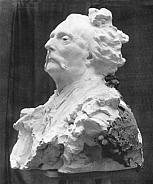|

"Barbey d'Aurevilly",
plaster re-edited by Rodin
with clay, 1909, photo by World's Graphic Press
|
Since we know Rodin developed many of his subjects from his
lifelong labour on "The Gates of Hell", and never ceased modifying and
combining these pieces, employing numerous assistants and artisans to translate
his models into marble and bronze, it has become almost impossible to single out
a specific object as "the" original of a certain line of subject
development. Instead, art history has accepted all objects the artist has
created with his own hands as originals; moreover, all objects whose production
was personally supervised and authorized wby the artist, with regard to their
final shape and finish, can be accepted as original works in a wider sense.
This restricts the use of the term "original" to
such objects, that were created during the artist´s lifetime. The art market
tends to use the term in an inflationary way, though.
|